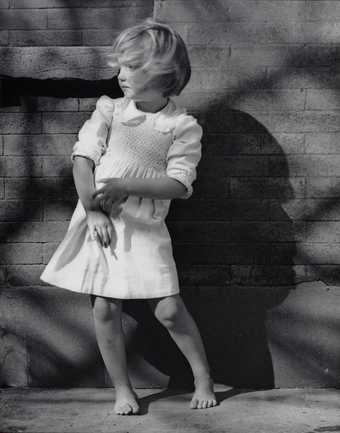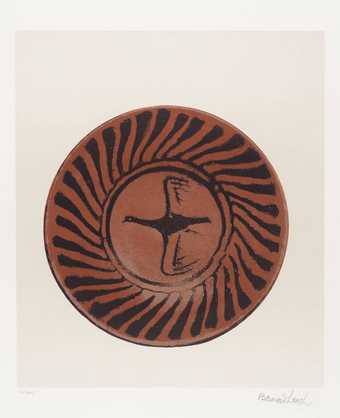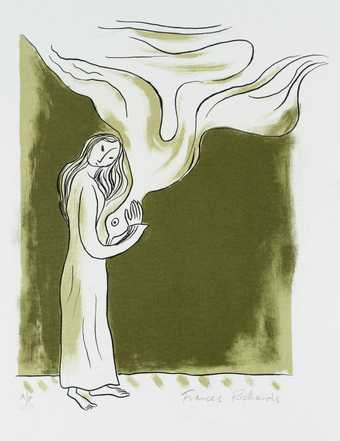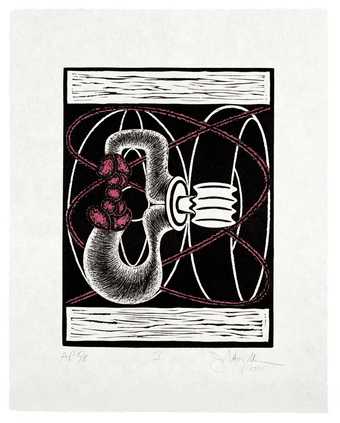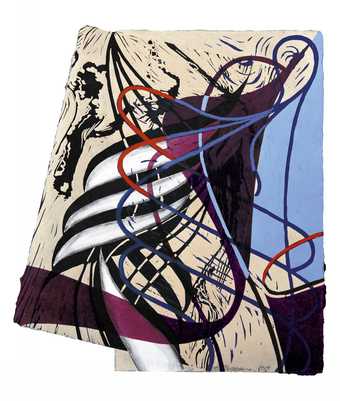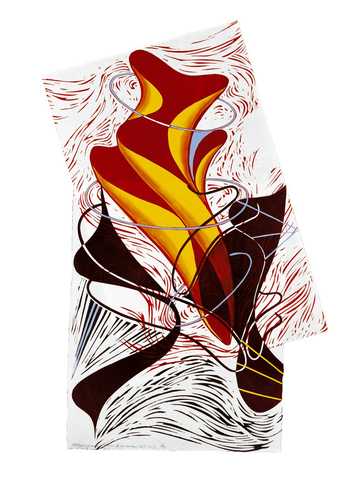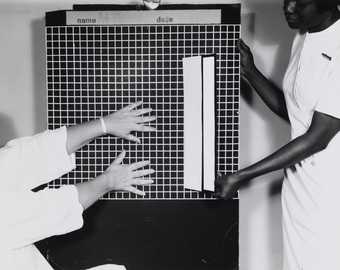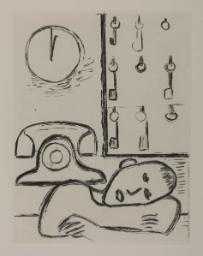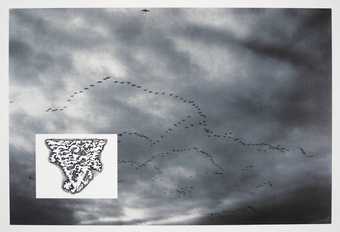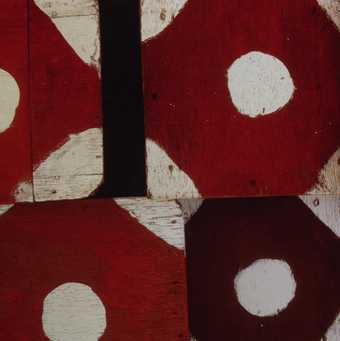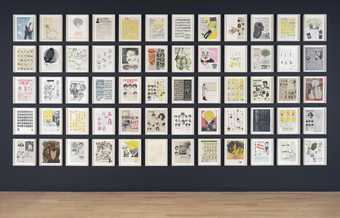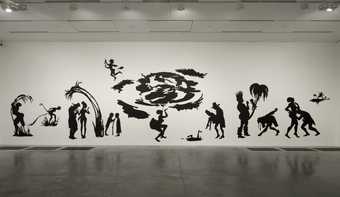
Not on display
- Artist
- Kara Walker born 1969
- Medium
- Linocut on paper
- Dimensions
- Support: 1175 × 1540 mm
- Collection
- Tate
- Acquisition
- Purchased 1998
- Reference
- P78211
Summary
The Keys to the Coop 1997 consists of a large linoleum silhouette printed in black ink that is mounted on white wove paper and features a young girl and a chicken composed in a cartoon-like style. The girl, who is seen in profile, wears a ragged short-sleeved dress and lace-up boots. She appears to be chasing the headless bird that has its feet and wings raised in a startled fashion on the left side of the work. The girl twirls a key (to which the title seems to refer) on one of her fingers, while in the other hand she holds a feathery object – possibly the chicken’s head – to her open mouth, from which the silhouette of her tongue protrudes. This print is number one in an edition of forty.
The Keys to the Coop was produced by the American artist Kara Walker in Providence, Rhode Island, where Walker completed a Masters of Fine Art at the Rhode Island School of Design in 1994. Walker began making paper cut-outs in 1993, creating silhouettes by drawing on black paper or linoleum with grease pencils or pastel crayons and then cutting out figures using a knife. The cut-outs are composed in reverse and then flipped for display, with the final figures mounted on canvas, wood or, as is the case with this work, on paper, while many of Walker’s larger silhouettes are affixed directly onto the gallery wall using wax.
Walker’s work has frequently explored the depiction of racial stereotypes in the United States, and in a 2011 interview she said, ‘The primary situation in my work is that of the African-American telling her story’ (Walker in ‘In the Studio: Kara Walker with Steel Stillman’, Art in America, May 2011, p.94). The Keys to the Coop can be seen to explore imagery and ideas often associated with slavery and African-American history. Walker’s depiction of a chicken may allude to how that animal has commonly been perceived as a favoured food for black people in the United States. Furthermore, in a 2005 article on this work, the art historian Alisa Swindell claimed that the girl’s ‘consumption of the usually discarded part of the chicken is a reminder that the slaves were underfed or given poor, generally unwanted cuts of meat, such as the head, feet, or entrails’ (Swindell 2005, p.6). As well as alluding to a chicken coop, the title of this work may be a reference to broader notions of containment, such as those involved in slavery, and their attendant power relations, where control over the ‘keys’ is paramount. In this respect, the girl’s action in the work may seem like an act of rebellion, albeit one that conforms to stereotypes concerning the wild and uncivilised behaviour of slaves.
Walker’s use of silhouettes is closely connected to her interest in exploring historical depictions of race. This format was popular in the eighteenth and nineteenth centuries, eras often evoked in the artist’s imagery, as can be seen in this work in the girl’s old-fashioned clothing. Insofar as silhouettes produce an image that reduces the full complexity of a figure, they can be compared with the simplistic ideas that underpin racial stereotypes. In a 1996 interview with the curator Elizabeth Armstrong, Walker explained:
The black silhouette just happened to suit my needs very well. I often compare my method of working to that of a well-meaning freed woman in a Northern state who is attempting to delineate the horrors of Southern slavery but with next to no resources, other than some paper and a pen knife and some people she’d like to kill. The silhouette speaks a kind of truth.
(Quoted in Armstrong 1997, p.106.)
Born in 1969 in California, Walker moved to the American state of Georgia in 1983, where she studied painting and printmaking at Atlanta College of Art, completing her degree in 1991. Her first large-scale wall-based silhouette work, Gone: An Historical Romance of a Civil War as it Occurred Between the Dusky Thighs of One Young Negress and Her Heart 1994 (Museum of Modern Art, New York), depicts a scene involving multiple figures on a plantation in the American South that was heavily influenced by the 1936 novel and 1939 film Gone with the Wind. Her practice has also included making drawings, paintings, watercolours and text-based works that further explore the imagery and language – often with explicit sexual or violent overtones – associated with race relations in the United States. In 1999 she began working with film, creating works that feature small hand puppets and employ overhead projections, as can be seen in 8 Possible Beginnings or: The Creation of African-America, a Moving Picture by Kara E. Walker 2005 (Tate T13714).
Further reading
Elizabeth Armstrong, ‘Kara Walker’, in No Place (Like Home), exhibition catalogue, Walker Art Center, Minneapolis 1997, pp.102–11.
Alisa Swindell, ‘Challenging Consumption: Kara Walker’s Keys to the Coop’, Gastronomica: The Journal of Food and Culture, vol.5, no.2, Spring 2005, pp.6–7.
Psyche A. Williams-Forso, Building Houses Out of Chicken Legs: Black Women, Food, and Power, Chapel Hill 2006, pp.199–218, reproduced p.202.
Richard Martin
June 2015
Supported by Christie’s.
Does this text contain inaccurate information or language that you feel we should improve or change? We would like to hear from you.
Explore
- emotions, concepts and ideas(16,416)
-
- formal qualities(12,454)
-
- silhouette(388)
- politics and society(2,337)
- actions: postures and motions(9,111)
-
- running(125)
- woman(9,110)
- black(796)
You might like
-
Robert Mapplethorpe Lindsay Key
1985 -
Sir Sidney Nolan The Questioning
1978–9 -
Bernard Leach Bird Dish
1973–4 -
Frances Richards Bottom
1973–5 -
John Newman Second Thoughts I
1995 -
Steven Sorman those from away IV
1989 -
Steven Sorman those from away VII
1989 -
Larry Sultan, Mike Mandel Untitled
1977, printed 2001 -
Louise Bourgeois Man, Keys, Phone, Clock
1994 -
Richard Deacon [no title]
1997 -
Aaron Siskind Bahia
1984 -
Ellen Gallagher DeLuxe
2004–5 -
Kara Walker Grub for Sharks: A Concession to the Negro Populace
2004 -
Lorna Simpson Photo Booth
2008

